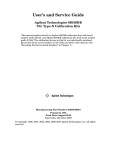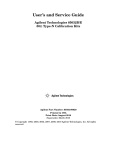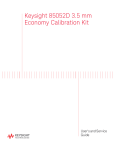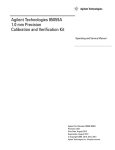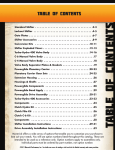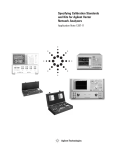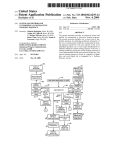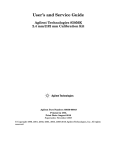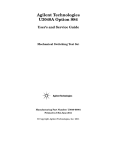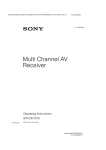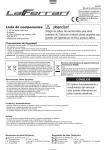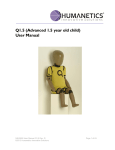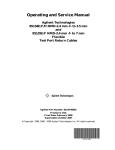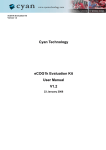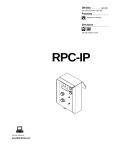Download Keysight Technologies 85036B/E 75Ω Type
Transcript
Keysight Technologies 85036B/E 75Ω Type-N Calibration Kits This manual applies directly to Keysight 85036B calibration kits with serial number prefix 3514A, and Keysight 85036E calibration kits with serial number prefix 3142A. The calibration devices in this kit are individually serialized. Record the device serial numbers in the table provided in this manual. (See “Recording the Device Serial Numbers” in Chapter 1.) User’s and Service Guide 85036B/E 3 Documentation Warranty THE MATERIAL CONTAINED IN THIS DOCUMENT IS PROVIDED "AS IS," AND IS SUBJECT TO BEING CHANGED, WITHOUT NOTICE, IN FUTURE EDITIONS. FURTHER, TO THE MAXIMUM EXTENT PERMITTED BY APPLICABLE LAW, KEYSIGHT DISCLAIMS ALL WARRANTIES, EITHER EXPRESS OR IMPLIED WITH REGARD TO THIS MANUAL AND ANY INFORMATION CONTAINED HEREIN, INCLUDING BUT NOT LIMITED TO THE IMPLIED WARRANTIES OF MERCHANTABILITY AND FITNESS FOR A PARTICULAR PURPOSE. KEYSIGHT SHALL NOT BE LIABLE FOR ERRORS OR FOR INCIDENTAL OR CONSEQUENTIAL DAMAGES IN CONNECTION WITH THE FURNISHING, USE, OR PERFORMANCE OF THIS DOCUMENT OR ANY INFORMATION CONTAINED HEREIN. SHOULD KEYSIGHT AND THE USER HAVE A SEPARATE WRITTEN AGREEMENT WITH WARRANTY TERMS COVERING THE MATERIAL IN THIS DOCUMENT THAT CONFLICT WITH THESE TERMS, THE WARRANTY TERMS IN THE SEPARATE AGREEMENT WILL CONTROL. Assistance Product maintenance agreements and other customer assistance agreements are available for Keysight products. For assistance, refer to “Contacting Keysight” on page 5-4. Printing Copies of On-Line Documentation To print copies of documentation from the Web, download the PDF file from the Keysight web site: • Go to www.keysight.com. • Enter the document’s part number (located on the title page) in the Search box. • Click Search. • Click on the hyperlink for the document. • Click the printer icon located in the tool bar. 4 85036B/E Contents 1. General Information Calibration Kit Overview. . . . . . . . . . . . . . . . . . . . . . . . . . . . . . . . . . . . . . . . . . . . . . . . . . . . . . . . . . . . . . . . . . . . . . . . . . . .1-2 Kit Contents . . . . . . . . . . . . . . . . . . . . . . . . . . . . . . . . . . . . . . . . . . . . . . . . . . . . . . . . . . . . . . . . . . . . . . . . . . . . . . . . . . . .1-2 Calibration Definitions . . . . . . . . . . . . . . . . . . . . . . . . . . . . . . . . . . . . . . . . . . . . . . . . . . . . . . . . . . . . . . . . . . . . . . . . . . .1-2 Equipment Required but Not Supplied . . . . . . . . . . . . . . . . . . . . . . . . . . . . . . . . . . . . . . . . . . . . . . . . . . . . . . . . . . . . . . .1-3 Incoming Inspection . . . . . . . . . . . . . . . . . . . . . . . . . . . . . . . . . . . . . . . . . . . . . . . . . . . . . . . . . . . . . . . . . . . . . . . . . . . . . . .1-4 Recording the Device Serial Numbers. . . . . . . . . . . . . . . . . . . . . . . . . . . . . . . . . . . . . . . . . . . . . . . . . . . . . . . . . . . . . . . . .1-5 Calibration Kits Documented in this Manual . . . . . . . . . . . . . . . . . . . . . . . . . . . . . . . . . . . . . . . . . . . . . . . . . . . . . . . . . . .1-6 Calibration Kit History . . . . . . . . . . . . . . . . . . . . . . . . . . . . . . . . . . . . . . . . . . . . . . . . . . . . . . . . . . . . . . . . . . . . . . . . . . . .1-6 Clarifying the Terminology of a Connector Interface . . . . . . . . . . . . . . . . . . . . . . . . . . . . . . . . . . . . . . . . . . . . . . . . . . . . .1-7 Preventive Maintenance . . . . . . . . . . . . . . . . . . . . . . . . . . . . . . . . . . . . . . . . . . . . . . . . . . . . . . . . . . . . . . . . . . . . . . . . . . . .1-7 When to Calibrate . . . . . . . . . . . . . . . . . . . . . . . . . . . . . . . . . . . . . . . . . . . . . . . . . . . . . . . . . . . . . . . . . . . . . . . . . . . . . . . . .1-7 2. Specifications Environmental Requirements . . . . . . . . . . . . . . . . . . . . . . . . . . . . . . . . . . . . . . . . . . . . . . . . . . . . . . . . . . . . . . . . . . . . . . . .2-2 Temperature—What to Watch Out For. . . . . . . . . . . . . . . . . . . . . . . . . . . . . . . . . . . . . . . . . . . . . . . . . . . . . . . . . . . . . . .2-2 Pin Depth Typical Values. . . . . . . . . . . . . . . . . . . . . . . . . . . . . . . . . . . . . . . . . . . . . . . . . . . . . . . . . . . . . . . . . . . . . . . . . . . .2-3 Electrical Specifications . . . . . . . . . . . . . . . . . . . . . . . . . . . . . . . . . . . . . . . . . . . . . . . . . . . . . . . . . . . . . . . . . . . . . . . . . . . .2-4 Certification . . . . . . . . . . . . . . . . . . . . . . . . . . . . . . . . . . . . . . . . . . . . . . . . . . . . . . . . . . . . . . . . . . . . . . . . . . . . . . . . . . . .2-4 3. Use, Maintenance, and Care of the Devices Electrostatic Discharge. . . . . . . . . . . . . . . . . . . . . . . . . . . . . . . . . . . . . . . . . . . . . . . . . . . . . . . . . . . . . . . . . . . . . . . . . . . . .3-2 Visual Inspection . . . . . . . . . . . . . . . . . . . . . . . . . . . . . . . . . . . . . . . . . . . . . . . . . . . . . . . . . . . . . . . . . . . . . . . . . . . . . . . . . .3-3 Look for Obvious Defects and Damage First . . . . . . . . . . . . . . . . . . . . . . . . . . . . . . . . . . . . . . . . . . . . . . . . . . . . . . . . . .3-3 Inspect the Mating Plane Surfaces . . . . . . . . . . . . . . . . . . . . . . . . . . . . . . . . . . . . . . . . . . . . . . . . . . . . . . . . . . . . . . . . .3-3 Cleaning Connectors . . . . . . . . . . . . . . . . . . . . . . . . . . . . . . . . . . . . . . . . . . . . . . . . . . . . . . . . . . . . . . . . . . . . . . . . . . . . . . .3-4 Connections . . . . . . . . . . . . . . . . . . . . . . . . . . . . . . . . . . . . . . . . . . . . . . . . . . . . . . . . . . . . . . . . . . . . . . . . . . . . . . . . . . . . . .3-6 How to Make a Connection. . . . . . . . . . . . . . . . . . . . . . . . . . . . . . . . . . . . . . . . . . . . . . . . . . . . . . . . . . . . . . . . . . . . . . . .3-6 How to Separate a Connection . . . . . . . . . . . . . . . . . . . . . . . . . . . . . . . . . . . . . . . . . . . . . . . . . . . . . . . . . . . . . . . . . . . . .3-9 Handling and Storage . . . . . . . . . . . . . . . . . . . . . . . . . . . . . . . . . . . . . . . . . . . . . . . . . . . . . . . . . . . . . . . . . . . . . . . . . . . . .3-10 4. Performance Verification Introduction . . . . . . . . . . . . . . . . . . . . . . . . . . . . . . . . . . . . . . . . . . . . . . . . . . . . . . . . . . . . . . . . . . . . . . . . . . . . . . . . . . . . . .4-2 How Keysight Verifies the Devices in This Kit. . . . . . . . . . . . . . . . . . . . . . . . . . . . . . . . . . . . . . . . . . . . . . . . . . . . . . . . .4-2 Recertification . . . . . . . . . . . . . . . . . . . . . . . . . . . . . . . . . . . . . . . . . . . . . . . . . . . . . . . . . . . . . . . . . . . . . . . . . . . . . . . . . . . .4-3 How Often to Recertify . . . . . . . . . . . . . . . . . . . . . . . . . . . . . . . . . . . . . . . . . . . . . . . . . . . . . . . . . . . . . . . . . . . . . . . . . . .4-3 Where to Send a Kit for Recertification . . . . . . . . . . . . . . . . . . . . . . . . . . . . . . . . . . . . . . . . . . . . . . . . . . . . . . . . . . . . . .4-3 5. Troubleshooting Troubleshooting Process. . . . . . . . . . . . . . . . . . . . . . . . . . . . . . . . . . . . . . . . . . . . . . . . . . . . . . . . . . . . . . . . . . . . . . . . . . . .5-2 Where to Look for More Information . . . . . . . . . . . . . . . . . . . . . . . . . . . . . . . . . . . . . . . . . . . . . . . . . . . . . . . . . . . . . . . . . .5-3 Returning a Kit or Device to Keysight . . . . . . . . . . . . . . . . . . . . . . . . . . . . . . . . . . . . . . . . . . . . . . . . . . . . . . . . . . . . . . . . .5-3 Contacting Keysight . . . . . . . . . . . . . . . . . . . . . . . . . . . . . . . . . . . . . . . . . . . . . . . . . . . . . . . . . . . . . . . . . . . . . . . . . . . . . . .5-4 6. Replaceable Parts 85036B/E 5 Contents Introduction . . . . . . . . . . . . . . . . . . . . . . . . . . . . . . . . . . . . . . . . . . . . . . . . . . . . . . . . . . . . . . . . . . . . . . . . . . . . . . . . . . . . . .6-2 A. Standard Definitions Class Assignments and Standard Definitions Values are Available on the Web . . . . . . . . . . . . . . . . . . . . . . . . . . . . . . A-2 6 85036B/E 1 General Information General Information Calibration Kit Overview Calibration Kit Overview The Keysight 85036B and 85036E type-N calibration kits are used to calibrate Keysight network analyzers up to 3 GHz for measurements of components with 75type-N connectors. Kit Contents Use the Contents List in the shipping container to verify the completeness of your shipment. Although this list is the most accurate, you can also use the illustrations in Chapter 7 to verify the items in your shipment. If your shipment is not complete, contact Keysight Technologies - refer to “Contacting Keysight” on page 5-4. Refer to Table 6-1 and Table 6-2 for a list of kit contents part numbers. Broadband Loads The broadband loads are instrument-grade, 75terminations that have been optimized for performance up to 3 GHz. The rugged internal structure provides for highly repeatable connections. A distributed resistive element on sapphire provides excellent stability and return loss. Opens and Shorts The opens and shorts are built from parts that are machined to the current state-of the-art precision machining. The short’s inner conductors have a one-piece construction, common with the shorting plane. This construction provides for extremely repeatable connections. The female open has a separate-piece inner conductor that is made from a low-dielectric-constant plastic to minimize compensation values. Both the opens and shorts are constructed so that the pin depth can be controlled very tightly, thereby minimizing phase errors. Some of the opens and shorts have offsets. The lengths of these offsets are designed so that the difference in phase of their reflection coefficients is approximately 180 degrees at all frequencies. Adapters Like the other devices in the kit, the adapters are built to very tight tolerances to provide good broadband performance. The adapters utilize a dual-beaded connector structure to ensure stable, repeatable connections. The beads are designed to minimize return loss and are separated far enough so that interaction between the beads is minimized. Calibration Definitions The calibration kit must be selected and the calibration definitions for the devices in the kit installed in the network analyzer prior to performing a calibration. Refer to your network analyzer user’s guide for instructions on selecting the calibration kit and performing a calibration. The calibration definitions can be: 1- 2 85036B/E General Information Calibration Kit Overview • resident within the analyzer • entered from the front panel Class assignments and standard definitions may change as more accurate model and calibration methods are developed. You can download the most recent class assignments and standard definitions from Keysight’s Calibration Kit Definitions Web page at http://na.support.keysight.com/pna/caldefs/stddefs.html NOTE The 8510 network analyzer is no longer being sold or supported by Keysight. However, you can download the 8510 class assignments and standard definitions from Keysight’s Calibration Kit Definitions Web page at http://na.support.keysight.com/pna/caldefs/stddefs.html Installation of the Calibration Definitions The calibration definitions for the kit may be permanently installed in the internal memory or hard disk of the network analyzer. If the calibration definitions for the kit are not permanently installed in the network analyzer, they must be manually entered. Refer to your network analyzer user’s guide for instructions. Equipment Required but Not Supplied Gages, torque and open-end wrenches, ESD protective devices, and various connector cleaning supplies are not included in the calibration kit but are required to ensure successful operation of the calibration kit. Refer to Table 6-3 on page 6-5 for ordering information. 85036B/E 1-3 General Information Incoming Inspection Incoming Inspection Check for damage. The foam-lined storage case provides protection during shipping. If the case or any device appears damaged, or if the shipment is incomplete, contact Keysight. See “Contacting Keysight” on page 5-4. Keysight will arrange for repair or replacement of incomplete or damaged shipments without waiting for a settlement from the transportation company. When you send the kit or device to Keysight, include a service tag (found near the end of this manual) with the following information: • your company name and address • the name of a technical contact person within your company, and the person's complete phone number • the model number and serial number of the kit • the part number and serial number of the device • the type of service required • a detailed description of the problem 1- 4 85036B/E General Information Recording the Device Serial Numbers Recording the Device Serial Numbers In addition to the kit serial number, the devices in this kit are individually serialized (serial numbers are labeled onto the body of each device). Record these serial numbers in Table 1-1 for the 85036B and Table 1-2 for the 85036E. Recording the serial numbers will prevent confusing the devices in this kit with similar devices in other kits. Table 1-1 Serial Number Record for 85036B Device Serial Number Calibration kit _______________________________ Male broadband load _______________________________ Female broadband load _______________________________ Male open _______________________________ Female open body _______________________________ Male short _______________________________ Female short _______________________________ Type-N male to male adapter _______________________________ Type-N- female to female adapter _______________________________ Type-N- male to female adapter _______________________________ Female open center-conductor extender _______________________________ Table 1-2 Serial Number Record for 85036E Device Serial Number Calibration kit _______________________________ Male broadband load _______________________________ Male combination open/short _______________________________ 85036B/E 1-5 General Information Calibration Kits Documented in this Manual Calibration Kits Documented in this Manual This manual applies to any 85036B or 85036E calibration kit whose serial prefix is listed on the title page. If your calibration kit has a different serial number prefix than the one listed on the title page, refer to “Calibration Kit History” below for information on how this manual applies. Calibration Kit History This section describes calibration kits with serial number prefixes different than those listed on the title page. Keysight 85036B kits with serial prefix 3102A and below • 75 ohm load specification: return loss 45 db, dc to 2 GHz • all other kit components unspecified 85036B calibration kits with serial number prefix 3102A and below should meet the specifications published in this manual. If you wish to have your kit recertified to current specifications, contact your nearest Keysight service center. For contact information, see “Contacting Keysight” on page 5-4. Keysight 85036B kits with serial prefix 3103A and below These calibration kits had a center conductor extender with a smaller body. Therefore, a different procedure was used for connecting the female open. If you’re using one of the smaller extenders, replace the steps in “Connecting and Disconnecting the Two-Piece Female Open (85036B)” on page 3-9 of this manual with the steps below. 1. Mate the center conductor extender to the male pin of the test port. 2. Connect the open body to the test port by carefully guiding it over the extender. 3. To disconnect the open, carefully remove the open body first. The part numbers in this manual are the recommended replacement parts for these kits (including the center conductor extender). 1- 6 85036B/E General Information Clarifying the Terminology of a Connector Interface Clarifying the Terminology of a Connector Interface In this document and in the prompts of the PNA calibration wizard, the gender of cable connectors and adapters is referred to in terms of the center conductor. For example, a connector or device designated as 1.85 mm –f– has a 1.85 mm female center conductor. 8510-series, 872x, and 875x ONLY: In contrast, during a measurement calibration, the network analyzer softkey menus label a 1.85 mm calibration device with reference to the sex of the analyzer’s test port connector—not the calibration device connector. For example, the label SHORT(F) refers to the short that is to be connected to the female test port. This will be a male short from the calibration kit. Table 1-3 Clarifying the Sex of Connectors: Examples Terminology Meaning Short –f– Female short (female center conductor) Short (f) Male short (male center conductor) to be connected to female port A connector gage is referred to in terms of the connector that it measures. For instance, a male connector gage has a female connector on the gage so that it can measure male devices. Preventive Maintenance The best techniques for maintaining the integrity of the devices in this kit include: • routine visual inspection • cleaning • proper gaging • proper connection techniques All of the above are described in Chapter 3 , “Use, Maintenance, and Care of the Devices.” Failure to detect and remove dirt or metallic particles on a mating plane surface can degrade repeatability and accuracy and can damage any connector mated to it. Improper connections, resulting from pin depth values being out of the limits (see Table 2-2 on page 2-3), or from bad connections, can also damage these devices. When to Calibrate A network analyzer calibration remains valid as long as the changes in the systematic error are insignificant. This means that changes to the uncorrected leakages (directivity and isolation), mismatches (source match and load match), and frequency response of the system are small (<10%) 85036B/E 1-7 General Information When to Calibrate relative to accuracy specifications. Change in the environment (especially temperature) between calibration and measurement is the major cause in calibration accuracy degradation. The major effect is a change in the physical length of external and internal cables. Other important causes are dirty and damaged test port connectors and calibration standards. If the connectors become dirty or damaged, measurement repeatability and accuracy is affected. Fortunately, it is relatively easy to evaluate the general validity of the calibration. To test repeatability, remeasure one of the calibration standards. If you can not obtain repeatable measurements from your calibration standards, maintenance needs to be performed on the test port connectors, cables and calibration standards. Also, maintain at least one sample of the device under test or some known device as your reference device. A verification kit may be used for this purpose. After calibration, measure the reference device and note its responses. Periodically remeasure the device and note any changes in its corrected response which can be attributed to the test system. With experience you will be able to see changes in the reference responses that indicate a need to perform the measurement calibration again. 1- 8 85036B/E 2 Specifications Specifications Environmental Requirements Environmental Requirements Table 2-1 Environmental Requirements Parameter Limits Operating temperaturea +15 C to +35 C (+59 F to +95 F) Error-corrected temperature rangeb 1 C of measurement calibration temperature Storage temperature 40 C to +75 C (40 F to +167 F) Relative humidity Type tested, 0% to 95% at 40 C, non-condensing a. The temperature range over which the calibration standards maintain conformance to their specifications. b. The allowable network analyzer ambient temperature drift during measurement calibration and during measurements when the network analyzer error correction is turned on. Also, the range over which the network analyzer maintains its specified performance while correction is turned on. Temperature—What to Watch Out For Changes in temperature can affect electrical characteristics. Therefore, the operating temperature is a critical factor in performance. During a measurement calibration, the temperature of the calibration devices must be stable and within the range specified in Table 2-1. IMPORTANT Avoid unnecessary handling of the devices during calibration because your fingers are a heat source. 2-2 85036B/E Specifications Pin Depth Typical Values Pin Depth Typical Values The pin depth typical values in Table 2-2 apply to the devices in the 85036B and the 85036E 75 type-N calibration kits.m Table 2-2 Pin Depth Typical Values Device Typical Pin Depth Inches Millimeters Fixed Load 0 to -0.0020 0 to -0.0508 Open Not Applicable Male Short 0 to -0.0020 0 to -0.0508 Female Short 0 to -0.004 0 to -0.1016 Combo Open/Short Male Open: Not Applicable Short: 0 to -0.0020 All Type-N Adapters 0 to -0.0030 0 to -0.0762 NOTE 85036B/E The gages for measuring type-N connectors compensate for the designed offset of 5.26 mm (0.207 inch), therefore, protrusion and recession readings are in relation to a zero reference plane (as if the inner and outer conductor planes were intended to be flush). Gage readings can be directly compared with the observed values listed in Table 2-2. 2-3 Specifications Electrical Specifications Electrical Specifications The electrical specifications in Table 2-3 apply to the devices in your calibration kit when connected with a Keysight precision interface. Table 2-3 Electrical Specifications Device Specification Frequency (GHz) Loadsa Return loss 46 dB 0.00501) DC to 2 Return loss 40 dB 0.01000) > 2 to 3 a. 23 +5 C; typical resistance change: ±300 ppm/C Certification Keysight Technologies certifies that this product met its published specifications at the time of shipment from the factory. Keysight further certifies that its calibration measurements are traceable to the United States National Institute of Standards and Technology (NIST) to the extent allowed by the institute’s calibration facility, and to the calibration facilities of other International Standards Organization members. See “How Keysight Verifies the Devices in This Kit” on page 4-2 for more information. 2-4 85036B/E 3 Use, Maintenance, and Care of the Devices Use, Maintenance, and Care of the Devices Electrostatic Discharge Electrostatic Discharge Protection against ESD (electrostatic discharge) is essential while connecting, inspecting, or cleaning connectors attached to a static-sensitive circuit (such as those found in test sets). Static electricity can build up on your body and can easily damage sensitive internal circuit elements when discharged. Static discharges too small to be felt can cause permanent damage. Devices such as calibration components and devices under test (DUTs), can also carry an electrostatic charge. To prevent damage to the test set, components, and devices: • always wear a grounded wrist strap having a 1 M resistor in series with it when handling components and devices or when making connections to the test set. • always use a grounded, conductive table mat while making connections. • always wear a heel strap when working in an area with a conductive floor. If you are uncertain about the conductivity of your floor, wear a heel strap. • always ground yourself before you clean, inspect, or make a connection to a static-sensitive device or test port. You can, for example, grasp the grounded outer shell of the test port or cable connector briefly. • always ground the center conductor of a test cable before making a connection to the analyzer test port or other static-sensitive device. This can be done as follows: 1. Connect a short (from your calibration kit) to one end of the cable to short the center conductor to the outer conductor. 2. While wearing a grounded wrist strap, grasp the outer shell of the cable connector. 3. Connect the other end of the cable to the test port. 4. Remove the short from the cable. Refer to Chapter 6 , “Replaceable Parts,” for part numbers and instructions for ordering ESD protective devices. Figure 3-1 3-2 ESD Protection Setup 85036B/E Use, Maintenance, and Care of the Devices Visual Inspection Visual Inspection Visual inspection and, if necessary, cleaning should be done every time a connection is made. Metal particles from the connector threads may fall into the connector when it is disconnected. One connection made with a dirty or damaged connector can damage both connectors beyond repair. Magnification is helpful when inspecting connectors, but it is not required and may actually be misleading. Defects and damage that cannot be seen without magnification generally have no effect on electrical or mechanical performance. Magnification is of great use in analyzing the nature and cause of damage and in cleaning connectors, but it is not required for inspection. Look for Obvious Defects and Damage First Examine the connectors first for obvious defects and damage: badly worn plating on the connector interface, deformed threads, or bent, broken, or misaligned center conductors. Connector nuts should move smoothly and be free of burrs, loose metal particles, and rough spots. What Causes Connector Wear? Connector wear is caused by connecting and disconnecting the devices. The more use a connector gets, the faster it wears and degrades. The wear is greatly accelerated when connectors are not kept clean, or are connected incorrectly. Connector wear eventually degrades performance of the device. Calibration devices should have a long life if their use is on the order of a few times per week. Replace devices with worn connectors. The test port connectors on the network analyzer test set may have many connections each day, and are therefore more subject to wear. It is recommended that an adapter be used as a test port saver to minimize the wear on the test set’s test port connectors. Inspect the Mating Plane Surfaces Flat contact between the connectors at all points on their mating plane surfaces is required for a good connection. Look especially for deep scratches or dents, and for dirt and metal particles on the connector mating plane surfaces. Also look for signs of damage due to excessive or uneven wear or misalignment. Light burnishing of the mating plane surfaces is normal, and is evident as light scratches or shallow circular marks distributed more or less uniformly over the mating plane surface. Other small defects and cosmetic imperfections are also normal. None of these affect electrical or mechanical performance. If a connector shows deep scratches or dents, particles clinging to the mating plane surfaces, or uneven wear, clean and inspect it again. Devices with damaged connectors should be discarded. Determine the cause of damage before connecting a new, undamaged connector in the same configuration. 85036B/E 3-3 Use, Maintenance, and Care of the Devices Cleaning Connectors Cleaning Connectors Clean connectors are essential for ensuring the integrity of RF and microwave coaxial connections. 1. Use Compressed Air or Nitrogen WARNING Always use protective eyewear when using compressed air or nitrogen. Use compressed air (or nitrogen) to loosen particles on the connector mating plane surfaces. You can use any source of clean, dry, low-pressure compressed air or nitrogen that has an effective oil-vapor filter and liquid condensation trap placed just before the outlet hose. Ground the hose nozzle to prevent electrostatic discharge, and set the air pressure to less than 414 kPa (60 psi) to control the velocity of the air stream. High-velocity streams of compressed air can cause electrostatic effects when directed into a connector. These electrostatic effects can damage the device. Refer to “Electrostatic Discharge” earlier in this chapter for additional information. 2. Clean the Connector Threads WARNING Keep isopropyl alcohol away from heat, sparks, and flame. Store in a tightly closed container. It is extremely flammable. In case of fire, use alcohol foam, dry chemical, or carbon dioxide; water may be ineffective. Use isopropyl alcohol with adequate ventilation and avoid contact with eyes, skin, and clothing. It causes skin irritation, may cause eye damage, and is harmful if swallowed or inhaled. It may be harmful if absorbed through the skin. Wash thoroughly after handling. In case of spill, soak up with sand or earth. Flush spill area with water. Dispose of isopropyl alcohol in accordance with all applicable federal, state, and local environmental regulations. Use a lint-free swab or cleaning cloth moistened with isopropyl alcohol to remove any dirt or stubborn contaminants on a connector that cannot be removed with compressed air or nitrogen. Refer to Table 6-3 on page 6-5 for a part number for cleaning swabs. a. Apply a small amount of isopropyl alcohol to a lint-free cleaning swab. b. Clean the connector threads. c. Let the alcohol evaporate, then blow the threads dry with a gentle stream of clean, low-pressure compressed air or nitrogen. Always completely dry a connector before you reassemble or use it. 3. Clean the Mating Plane Surfaces a. Apply a small amount of isopropyl alcohol to a lint-free cleaning swab. b. Clean the center and outer conductor mating plane surfaces. When cleaning a female connector, avoid snagging the swab on the center conductor contact fingers by using short strokes. c. Let the alcohol evaporate, then blow the connector dry with a gentle stream of clean, low-pressure compressed air or nitrogen. Always completely dry a connector before you 3-4 85036B/E Use, Maintenance, and Care of the Devices Cleaning Connectors reassemble or use it. 4. Inspect Inspect the connector to make sure that no particles or residue remain. Refer to “Visual Inspection” on page 3-3. 85036B/E 3-5 Use, Maintenance, and Care of the Devices Connections Connections Good connections require a skilled operator. The most common cause of measurement error is bad connections. The following procedures illustrate how to make good connections. CAUTION Never mate a 50 ohm connector with a 75 ohm connector. The larger center pin of a male 50 ohm connector will destroy the contact fingers of a female 75 ohm connector. How to Make a Connection Preliminary Connection 1. Ground yourself and all devices. Wear a grounded wrist strap and work on a grounded, conductive table mat. Refer to “Electrostatic Discharge” on page 3-2 for ESD precautions. 2. Visually inspect the connectors. Refer to “Visual Inspection” on page 3-3. 3. If necessary, clean the connectors. Refer to “Cleaning Connectors” on page 3-4. 4. Carefully align the connectors. The male connector center pin must slip concentrically into the contact finger of the female connector. 5. Push the connectors straight together. CAUTION Do not turn the device body. Only turn the connector nut. Damage to the center conductor can occur if the device body is twisted. Do not twist or screw the connectors together. As the center conductors mate, there is usually a slight resistance. 6. The preliminary connection is tight enough when the mating plane surfaces make uniform, light contact. Do not overtighten this connection. A connection in which the outer conductors make gentle contact at all points on both mating surfaces is sufficient. Very light finger pressure is enough to accomplish this. 7. Make sure the connectors are properly supported. Relieve any side pressure on the connection from long or heavy devices or cables. Final Connection Using a Torque Wrench 1. Use a torque wrench to make a final connection. Table 3-1 provides information about the torque wrench recommended for use with this calibration kit. A torque wrench is not included in the calibration kit. Refer to Chapter 6 for part number and ordering information. 3-6 85036B/E Use, Maintenance, and Care of the Devices Connections Table 3-1 Torque Wrench Information Connector Type Torque Setting Torque Tolerance Type-N 135 N-cm (12 in-lb) 13.5 N-cm (1.2 in-lb) Using a torque wrench guarantees that the connection is not too tight, preventing possible connector damage. It also guarantees that all connections are equally tight each time. 2. Prevent the rotation of anything other than the connector nut that you are tightening. It may be possible to do this by hand if one of the connectors is fixed (as on a test port). In all situations, however, it is recommended that you use an open-end wrench to keep the body of the device from turning. Refer to Chapter 6 “Replaceable Parts” for part number and ordering information. 3. Position both wrenches within 90 degrees of each other before applying force. See Figure 3-2. Wrenches opposing each other (greater than 90 degrees apart) will cause a lifting action which can misalign and stress the connections of the devices involved. This is especially true when several devices are connected together. Figure 3-2 85036B/E Wrench Positions 3-7 Use, Maintenance, and Care of the Devices Connections 4. Hold the torque wrench lightly, at the end of the handle only (beyond the groove). See Figure 3-3. Figure 3-3 Using the Torque Wrench 5. Apply downward force perpendicular to the wrench handle. See Figure 3-3. This applies torque to the connection through the wrench. Do not hold the wrench so tightly that you push the handle straight down along its length rather than pivoting it, otherwise you apply an unknown amount of torque. 6. Tighten the connection just to the torque wrench break point. The wrench handle gives way at its internal pivot point. See Figure 3-3. Do not tighten the connection further. CAUTION You don’t have to fully break the handle of the torque wrench to reach the specified torque; doing so can cause the handle to kick back and loosen the connection. Any give at all in the handle is sufficient torque. Do not pivot the wrench handle on your thumb or other fingers, otherwise you apply an unknown amount of torque to the connection when the wrench reaches its break point. Do not twist the head of the wrench relative to the outer conductor mating plane. If you do, you apply more than the recommended torque. 3-8 85036B/E Use, Maintenance, and Care of the Devices Connections Connecting and Disconnecting the Two-Piece Female Open (85036B) The female open standard in the 85036B calibration kit is composed of two parts: the open body (outer conductor) and the center conductor extender. Refer to Figure 3-4. Figure 3-4 Connecting the Two-Piece Female Open To connect the female open: 1. Connect the open body to the male test port. 2. Insert the center conductor extender into the hole at the end of the body and push gently until the center conductors mate. To disconnect the female open: 1. Remove the center conductor extender by pulling gently outwards without twisting, rocking, or bending the extender or the body. 2. Disconnect the body from the test port. How to Separate a Connection To avoid lateral (bending) force on the connector mating plane surfaces, always support the devices and connections. CAUTION Turn the connector nut, not the device body. Major damage to the center conductor can occur if the device body is twisted. 1. Use an open-end wrench to prevent the device body from turning. 2. Use another open-end wrench to loosen the connector nut. 3. Complete the separation by hand, turning only the connector nut. 4. Pull the connectors straight apart without twisting, rocking, or bending either of the connectors. 85036B/E 3-9 Use, Maintenance, and Care of the Devices Handling and Storage Handling and Storage • Install the protective end caps and store the calibration devices in the foam-lined storage case when not in use. • Never store connectors loose in a box, desk, or bench drawer. This is the most common cause of connector damage during storage. • Keep connectors clean. • Do not touch mating plane surfaces. Natural skin oils and microscopic particles of dirt are easily transferred to a connector interface and are very difficult to remove. • Do not set connectors contact-end down on a hard surface. The plating and the mating plane surfaces can be damaged if the interface comes in contact with any hard surface. 3-10 85036B/E 4 Performance Verification Performance Verification Introduction Introduction The performance of your calibration kit can only be verified by returning the kit to Keysight Technologies for recertification. The equipment required to verify the specifications of the devices in the kit has been specially manufactured and is not commercially available. How Keysight Verifies the Devices in This Kit Keysight verifies the specifications of these devices as follows: 1. The residual microwave error terms of the test system are verified with precision airlines and shorts that are directly traced to NIST (National Institute of Standards and Technology). The airline and short characteristics are developed from mechanical measurements. The mechanical measurements and material properties are carefully modeled to give very accurate electrical representation. The mechanical measurements are then traced to NIST through various plug and ring gages and other mechanical measurements. 2. Each calibration device is electrically tested on this system. For the initial (before sale) testing of the calibration devices, Keysight includes the test measurement uncertainty as a guardband to guarantee each device meets the published specification. For recertifications (after sale), no guardband is used and the measured data is compared directly with the specification to determine the pass or fail status. The measurement uncertainty for each device is, however, recorded in the calibration report that accompanies recertified kits. These two steps establish a traceable link to NIST for Keysight to the extent allowed by the institute’s calibration facility. The specifications data provided for the devices in this kit is traceable to NIST through Keysight Technologies. 4-2 85036B/E Performance Verification Recertification Recertification The following will be provided with a recertified kit: • • • a new calibration sticker affixed to the case a certificate of calibration a calibration report for each device in the kit listing measured values, specifications, and uncertainties NOTE A list of NIST traceable numbers may be purchased upon request to be included in the calibration report. Keysight Technologies offers a Standard calibration for the recertification of this kit. For more information, contact Keysight Technologies. See “Contacting Keysight” on page 5-4. How Often to Recertify The suggested initial interval for recertification is 12 months or sooner. The actual need for recertification depends on the use of the kit. After reviewing the results of the initial recertification, you may establish a different recertification interval that reflects the usage and wear of the kit. NOTE The recertification interval should begin on the date the kit is first used after the recertification date. Where to Send a Kit for Recertification Contact Keysight Technologies for information on where to send your kit for recertification. See “Contacting Keysight” on page 5-4. When you return the kit, complete and attach a service tag. Refer to “Returning a Kit or Device to Keysight” on page 5-3 for details. 85036B/E 4-3 Performance Verification Recertification 4-4 85036B/E 5 Troubleshooting Troubleshooting Troubleshooting Process Troubleshooting Process If you suspect a bad calibration, or if your network analyzer does not pass performance verification, follow the steps in Figure 5-1. Figure 5-1 5-2 Troubleshooting Flowchart 85036B/E Troubleshooting Where to Look for More Information Where to Look for More Information This manual contains limited information about network analyzer system operation. For detailed information on using a VNA, ENA or PNA series network analyzer, refer to the appropriate user guide or online Help. • To view the ENA or PNA online Help, press the Help key on the front panel of the network analyzer. • To view an online VNA user guide, use the following steps: 1. Go to www.keysight.com. 2. Enter your VNA model number (Ex: N5242A) in the Search box and click Search. 3. Under the heading Manuals & Guides, click on the title/hyperlink for the document PDF you want to view. If you need additional information, see “Contacting Keysight” on page 5-4. Returning a Kit or Device to Keysight If your kit or device requires service, contact the Keysight Technologies office nearest you for information on where to send it. See “Contacting Keysight” below. Include a service tag (located near the end of this manual) on which you provide the following information: • your company name and address • a technical contact person within your company, and the person's complete phone number • the model number and serial number of the kit • the part number and serial number of each device • the type of service required • a detailed description of the problem and how the device was being used when the problem occurred (such as calibration or measurement) 85036B/E 5-3 Troubleshooting Contacting Keysight Contacting Keysight Assistance with test and measurements needs and information on finding a local Keysight office are available on the Web at: www.keysight.com/find/assist If you do not have access to the Internet, please contact your Keysight field engineer. NOTE 5-4 In any correspondence or telephone conversation, refer to the Keysight product by its model number and full serial number. With this information, the Keysight representative can determine whether your product is still within its warranty period. 85036B/E 6 Replaceable Parts Replaceable Parts Introduction Introduction Table 6-1 lists the replacement part numbers for items included in the 85036B calibration kit and Figure 6-1 illustrates each of these items. Table 6-2 lists the replacement part numbers for items included in the 85036E calibration kit and Figure 6-2 illustrates each of these items. Table 6-3 lists the replacement part numbers for items recommended or required for successful operation but not included in the calibration kit. To order a listed part, note the description, part number, and quantity desired. Telephone or send your order to Keysight Technologies. See “Contacting Keysight” on page 5-4. Table 6-1 Replaceable Parts for the 85036B Calibration Kit Item No. Description Qty Per Kit Keysight Part Number Calibration Devices (75 Type-N)a 1 Male broadband load 1 00909-60019 2 Female broadband load 1 00909-60020 3 Male short 1 85036-60012 4 Female short 1 85036-60011 5 Male open 1 85032-60007 6 Female open body 1 85032-20001 7 Female open center conductor extender 1 85036-60010 Adapters 8 Type-N-male to male 1 85036-60013 9 Type-N-female to female 1 85036-60014 10 Type-N-male to female 1 85036-60015 Calibration Kit Storage Case 11 Box 1 85036-80001 12 Foam pad set 1 85036-80002 85036-90016 Miscellaneous Items 13 User’s and service guideb 1 14 Male protective end caps as required 1401-0214 15 Female protective end caps as required 1401-0225 16 Tube package (for center conductor extender) 1 1540-1027 a. Refer to “Clarifying the Terminology of a Connector Interface” on page 1-7. b. See “Printing Copies of On-Line Documentation” on page -4. 6-2 85036B/E Replaceable Parts Introduction Figure 6-1 85036B/E Replaceable Parts for the 85036B Calibration Kit 6-3 Replaceable Parts Introduction Table 6-2 Replaceable Parts for the 85036E Calibration Kit Description Item No. Qty Per Kit Keysight Part Number Calibration Devices (75 Type-N) 1 Male broadband load 1 00909-60019 2 Male combination open/short 1 85036-60016 Calibration Kit Storage Case 3 Box 1 9211-1582 4 Foam pad set 1 85023-80005 Miscellaneous Items 5 User’s and service guidea 1 6 Male protective end cap as required 85036-90016 1401-0214 a. See “Printing Copies of On-Line Documentation” on page -4. Figure 6-2 6-4 Replaceable Parts for the 85036E Calibration Kit 85036B/E Replaceable Parts Introduction Table 6-3 Replaceable Parts—Items Not Included in the 85036B and 85036E Calibration Kits Description Qty Keysight Part Number Connector Gages (75 Type-N) Connector gage set 1 85036B K01 3/4 in, 135 N-cm (12 in-lb) torque wrench 1 8710-1766 1/2 in and 9/16 in open-end wrench 1 8710-1770 3/4 in open-end wrench 1 8720-0011 Grounding wrist strap 1 9300-1367 5 ft grounding cord for wrist strap 1 9300-0980 2 ft by 4 ft conductive table mat with 15 ft grounding wire 1 9300-0797 ESD heel strap 1 9300-1308 Wrenches ESD Protective Devices Connector Cleaning Supplies Anhydrous isopropyl alcohol (92% pure)a Foam tipped cleaning swabs 30 ml 100 -9301-1243 Miscellaneous Items Connector care - quick reference card 1 08510-90360 a. Keysight can no longer safely ship isopropyl alcohol, so customers should purchase it locally. 85036B/E 6-5 Replaceable Parts Introduction 6-6 85036B/E A Standard Definitions Standard Definitions Class Assignments and Standard Definitions Values are Available on the Web Class Assignments and Standard Definitions Values are Available on the Web Class assignments and standard definitions may change as more accurate model and calibration methods are developed. You can download the most recent class assignments and standard definitions from Keysight’s Calibration Kit Definitions Web page at http://na.support.keysight.com/pna/caldefs/stddefs.html. For a detailed discussion of calibration kits, refer to the Keysight Application Note, “Specifying Calibration Standards and Kits for Keysight Vector Network Analyzers.” This application note covers calibration standard definitions, calibration kit content and its structure requirements for Keysight vector network analyzers. It also provides some examples of how to set up a new calibration kit and how to modify an existing calibration kit definition file. To download a free copy, go to www.keysight.com and enter literature number 5989-4840EN in the Search window. A-2 85036B/E Index Numerics 8510 network analyzer, 1-3 A adapters, 1-2 part numbers, 6-5 alcohol isopropyl as cleaning solvent, 3-4 B broadband loads, 1-2 C cal kit contents, 1-2 overview, 1-2 return to Keysight, 5-3 serial number, 1-5 calibration bad, 5-2 certificate of, 4-2 constants permanently stored, 1-3 constants, See calibration definitions definitions entering, 1-2 permanently stored, 1-2 frequency, 1-7 label, 4-3 label part number, 6-5 report, 4-2 standards, 2-4 temperature, 2-2 when to perform, 1-7 calibration kit Keysight Application Note, A-2 contents, 1-2 history, 1-6 modifying definition files, A-2 overview, 1-2 return to Keysight, 5-3 serial number, 1-5 certificate of calibration, 4-2 certification specifications, 2-4 class assignments downloading from Keysight Web site, A-2 cleaning connectors, 3-3 cleaning supplies, 1-3 ordering, 6-5 part numbers, 6-5 compressed air or nitrogen, 3-3 connections, 3-2, 3-5, 3-8 cautions in making, 3-5 disconnecting, 3-8 ESD concerns, 3-5 final, 3-5 how to make, 3-5 85036B/E preliminary, 3-5 two-piece female open, 3-8 undoing, 3-8 using a torque wrench, 3-5 connector cleaning, 3-3 cleaning supplies, 6-5 damage, 3-3 life, 3-3 mating plane, 3-4 sex, 1-7 threads, 3-4 visual inspection, 3-3 wear, 3-3 constants, calibration, See calibration definitions contacting Keysight Technologies, 5-3 contents kit, 1-2 D damage shipment, 1-4 to connectors, 3-3 data, recertification, 4-2 defective connectors, 3-3 definitions calibration, 1-2 device connecting, 3-5 disconnecting, 3-8 handling, 3-9 how Keysight verifies, 4-2 maintenance, 1-7 part numbers, 6-5 return to Keysight, 5-3 serial numbers, 1-5 storage, 3-9 temperature, 2-2 visual inspection, 3-3 disconnecting the two-piece female open, 3-8 disconnections, 3-8 documentation warranty, -ii downloading class assignments & std definitions from the Web, A-2 E electrical specifications, 2-4 electrostatic discharge, 3-2 supplies part numbers, 6-5 when making connections, 3-5 environmental requirements, 2-2 equipment required, 1-3 but not supplied, 1-3, 6-2, 6-5 supplied, 1-2, 6-2, 6-4 ESD, 3-2 precautions, 3-2, 3-3 supplies Index- 1 Index part numbers, 6-5 when making connections, 3-5 F female open, 3-8 connecting, 3-8 disconnecting, 3-8 frequency range, 2-4 specifications, 2-4 frequency of calibration, 1-7 G gage connector master, 6-5 gage master part numbers, 6-5 gender, connector, 1-7 H handling, 3-9 history, calibration kit, 1-6 how often to calibrate, 1-7 humidity, 2-2 I incoming inspection, 1-4 information, troubleshooting, 5-3 inspection damage, 3-3 defects, 3-3 incoming, 1-4 mating plane, 3-3 visual, 3-3 isopropyl alcohol as cleaning solvent, 3-4 K Keysight application note, A-2 offices, 5-3 kit contents, 1-2 overview, 1-2 return to Keysight, 5-3 serial number, 1-5 L label calibration, 4-3 part number, 6-5 loads broadband, 1-2 M maintenance, 3-2 preventive, 1-7 Index-2 making connections, 3-5 manual part number, 6-5 printing, -ii mating plane connector, 3-4 inspection, 3-3 surfaces, 3-4 modifying calibration kit definition files, A-2 N network analyzer, 8510, 1-3 nitrogen, 3-3 numbers serial, 1-5 recording, 1-5 O offices contacting Keysight, 5-3 open-end wrench, 1-3, 3-8 part number, 6-5 opens, 1-2 ordering parts, 6-2 P part numbers, 6-2 parts ordering, 6-2 replaceable, 6-2 required but not supplied, 6-2 performance verification, 4-2 fail, 5-2 permanently stored calibration definitions, 1-3 pin depth typical values, 2-3 preventive maintenance, 1-7 printing the manual, -ii R recertification, 4-3 how often?, 4-3 interval, 4-3 what's included, 4-3 where to send your kit, 4-3 regulations environmental, 3-4 replaceable parts, 6-2 requirements environmental, 2-2 return loss specifications, 2-4 return, kit or device, 5-3 S sales contacting Keysight, 5-3 serial numbers, 1-5 devices, 1-5 85036B/E Index recording, 1-5 service, 5-2 contacting Keysight, 5-3 service tag, 1-4, 4-3, 5-3 sex, connector, 1-7 shipment damage, 1-4 verifying complete, 1-4 shorts, 1-2 specifications, 2-2 certification, 2-4 electrical, 2-4 environmental, 2-2 frequency, 2-4 humidity, 2-2 return loss, 2-4 temperature, 2-2 verifying, 4-2 standard definitions downloading from Keysight Web site, A-2 standards calibration, 2-4 NIST, 2-4, 4-3 static discharge, 3-2 sticker calibration, 4-3 storage, 3-9 temperature, 2-2 supplies cleaning, 1-3 wrench open-end, 1-3, 3-8 part number, 6-5 undoing connections, 3-8 torque, 1-3 part number, 6-5 T tag service, 1-4, 4-3, 5-3 temperature calibration, 2-2 device, 2-2 error-corrected temperature range, 2-2 measurement, 2-2 operating range, 2-2 verification and measurement, 2-2 test data, 4-2 threads connector, 3-4 torque wrench, 1-3, 3-5 part number, 6-5 specifications, 3-5 traceability, 4-2 troubleshooting, 5-2 two-piece female open, 3-8 V verification performance, 4-2 temperature, 2-2 visual inspection, 3-3 W warranty, documentation, -ii when to calibrate, 1-7 85036B/E Index- 3 This information is subject to change without notice. © Keysight Technologies 1995 - 2015 Edition 1 May 2015 Printed in USA/Malaysia *85036-90016* 85036-90016
















































